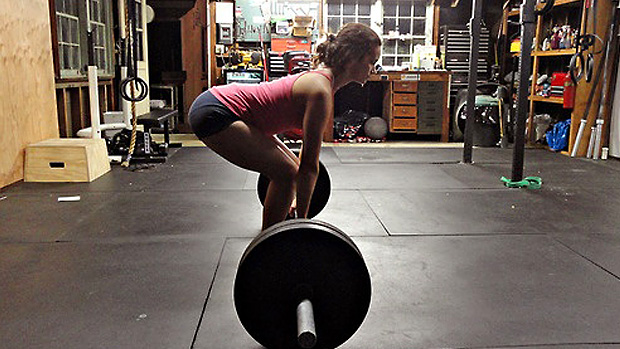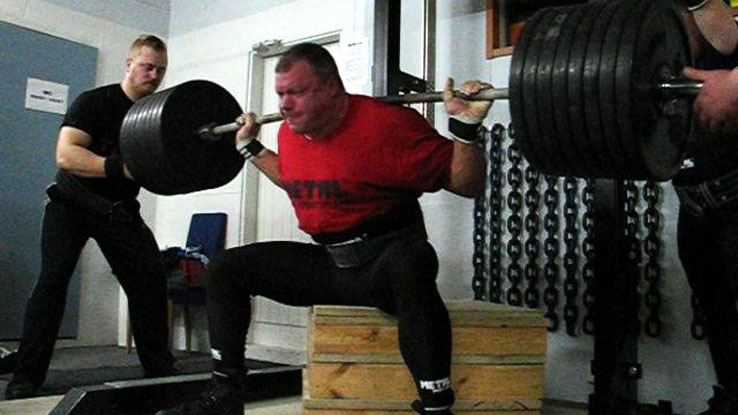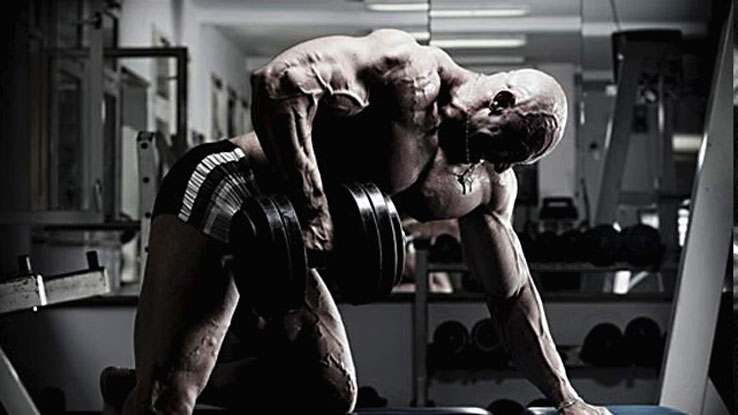Here's what you need to know...
- It's a mistake to equip your gym too well in the beginning. Building a perfect home gym should take a few years.
- Outfitting a gym comes down to cost vs. benefit. Buy the good stuff you really need and get the rest cheap (or build it yourself.)
- It's hard to beat a couple of kettlebells for swings, goblet squats and presses. They're portable and space efficient.
- When training outdoors, the TRX and a kettlebell can turn any place into a full gym.
- The ab wheel is the absolute king of full body tension and it can help your pull-up power.
- Other things you might want to include: climbing ropes, a Prowler, chalkboards, and heavy bags for carries.
Open 24 Hours, No Membership Fees
I hate commercial gyms. I can't stand public training facilities of any kind.
Since 1971, the bulk of my training has been in my backyard and my garage. When you add up the commute time, the gym fees, and the hassle of dealing with some oily teen who slimes every flat surface in the facility, I prefer to stay home.
Here are some tips for constructing your own home gym.

Building a perfect home gym might take a few years. In fact, it's a mistake to equip your gym too well in the beginning. You want your gym to "grow" as you know you can commit to more and more work.
Having a perfect home gym from the start will look pretty when you give tours, but it might consist of some equipment you never use. When the money is coming out of your own pocket, it helps to "know" that you're going to use a piece of equipment.
Outfitting a home gym comes down to cost vs. benefit. If you're an elite Olympic lifter, you might want to have the finest barbell in the world, but if you're like me and only lift in a few meets a year, a clunker works pretty good. It might sound cheap, but most of the equipment you might collect for my idea of a perfect home gym is usually bought at discount or rigged together with your own hands.
The perfect gym is of course going to involve some personal taste. There's no right or wrong here, so let's simply look at what I like and need and feel free to add and subtract.
An Olympic Barbell and Plates: If you're pressing, squatting, or deadlifting, you need a bar. How much weight you need to load it is a tough one.
When you train at home by yourself, you're going to find that for a number of reasons, you might need less than you think. I err on the side of safety. I strive to make every lift and never miss.
One important piece of advice learned the hard way: When you train at home, you often have expensive stuff close to you. For years I trained with my wife's new car right behind my platform. If I missed a lift or bounced the plates, it would hit the car.

I don't fear missing lifts, I fear my wife. Don't miss your lifts if you have expensive stuff close to you or a have a wife that can deal out severe punishment.
A Kettlebell: It's hard to replace a kettlebell for things like goblet squats and swings. I have fourteen in my gym now, but I train groups at my house. For most, one is pretty good and maybe a few pairs of kettlebells is good for doubles work, too.
Originally, I only had one 28-kilo kettlebell and I tried to master all the moves on this one bell. It was far too heavy for some of the movements, but it was great for the swing, the press, and the Goblet squat.
I'm sure you can do much of the kettlebell work with other equipment, but kettlebells have one big advantage: being able to take them to a field or park. My 28-kilo and I have had many adventures and it sits right behind me in my car. Sometimes I talk to it, too. It's a good listener.
TRX or Similar: I like the vast number of pulls I can do with the TRX. I can make things easier or harder with a step and I can really play with some of my weak areas. When training outdoors, the TRX and your kettlebell can turn any place into a full workout facility. Likewise, they take up very little space when not in use.
Ab Wheels: I get the cheap ones for ten dollars. Seriously. About two weeks after New Years is the best time to buy lower-end gym equipment.
The ab wheel is the absolute king of full body tension and it can help your pull-up power and counter the effects of lots of hip hinging. Recently, I picked up a big steel version as I often tend to break the plastic ones. It has rollerblade wheels and can support large people without fear of smashing their face on the floor.
I don't have a bench in my gym. It takes up a lot of space and most people just don't need to bench as much as they think. I do have squat racks, but you could certainly just clean the bar up and do squats like the old timers did a century ago. I do have a pull up/dip combo, though, and it's certainly been worthwhile.
These three aforementioned pieces of equipment can be expensive and take up a lot of space. This is where having a "perfect gym" is problematical: trade offs. I like a lot of ground in my gym since the floor is an often forgotten area to train.
Since the onset of machines, most gyms try to cram every square inch with crap. My floors are for Olympic lifts, Turkish get ups, rolling (foam and tumbling), corrective work, and mobility/flexibility work. Space is precious in most home gyms, so use it wisely.

I like everything to have a place, so I invested in a rack to hold my kettlebells. You could do without one; they can sit right against the wall and take up very little space. I always have at least fourteen kettlebells in the gym and the three shelves hold them all.
I'd also recommend plastic bins to hold things like pads, foam rollers, ab wheels, or anything else that might tend to clutter up the place.

I have a long rope in the backyard that serves a dual purpose. It's mounted fairly high up a tree for rope climbing, but it extends far down into the yard, too. You can do battling ropes and then climb the rope for the best ab workout I know while pretending to be Tarzan. Rope climbing is still the most underrated training tool I know.
Next to the rope are two gymnastic rings. I do a variety of things from simple pull-ups (the rings rotate into a position that seems to save the elbows) to a bunch of crow's nests and other gymnastic moves. Nothing too fancy, but they're an excellent and fun method for developing grip and core strength.
I also have three bags. One weighs 25 pounds, one weighs 50, and the big one is 80. I love bag carries, especially the bear hug. I do a great little workout I call "Bear/Bear" where I carry the heavy bag in a bear hug for a ways, drop it, and bear crawl back. Then I bear crawl back to the bag and bear hug it back.

These bags are very inexpensive. You can even use the salt bags made for water softeners and toss them in a duffel bag. How you train with them is only constrained by your imagination.
I also have loadable farmer's walk bars, but can get by doing your farmer's walks with kettlebells or a trap bar.

I use PVC pipes for making practice Scottish hammers, parallettes bars, and slosh pipes. I love making my own equipment and many of the ideas are absolute idiocy, but it's fun.
My first sled was a broken wheelbarrow loaded with concrete. Today, I have a nice fancy one and a Prowler, but nothing was as fun as sprinting with the rusty old wheelbarrow scraping the earth and making a noise like a fighter jet. Sigh.

You also need to cover the walls with white boards to record thoughts and ideas and maybe even the workout. A clock or two is also helpful and my friends are great at providing fun stuff for the wall.
Beyond all the equipment, my gym is a "No Eye Wash Zone." That's Major League Baseball talk for "no bullshit." Without discipline and enthusiasm, equipment just doesn't matter.





